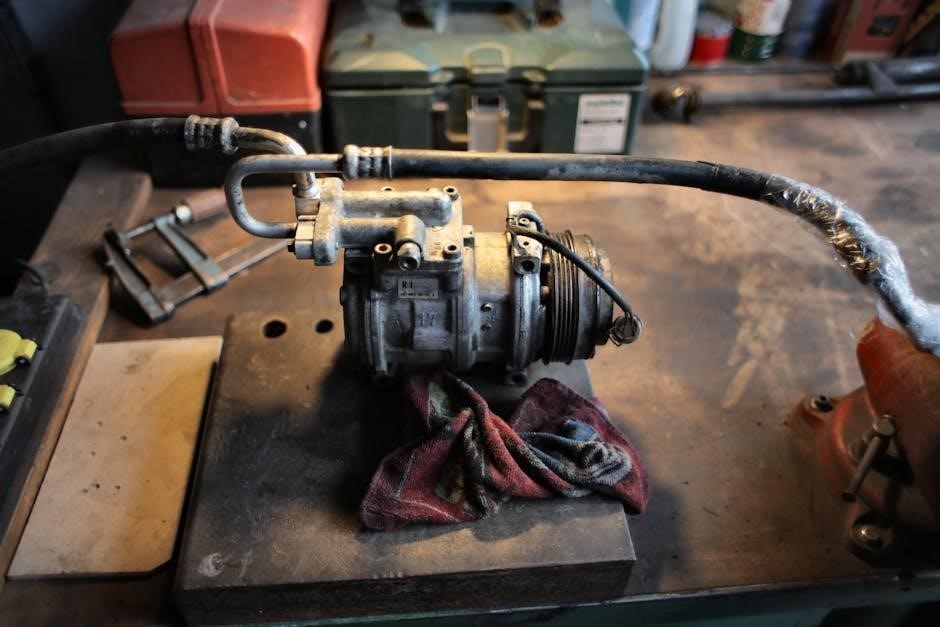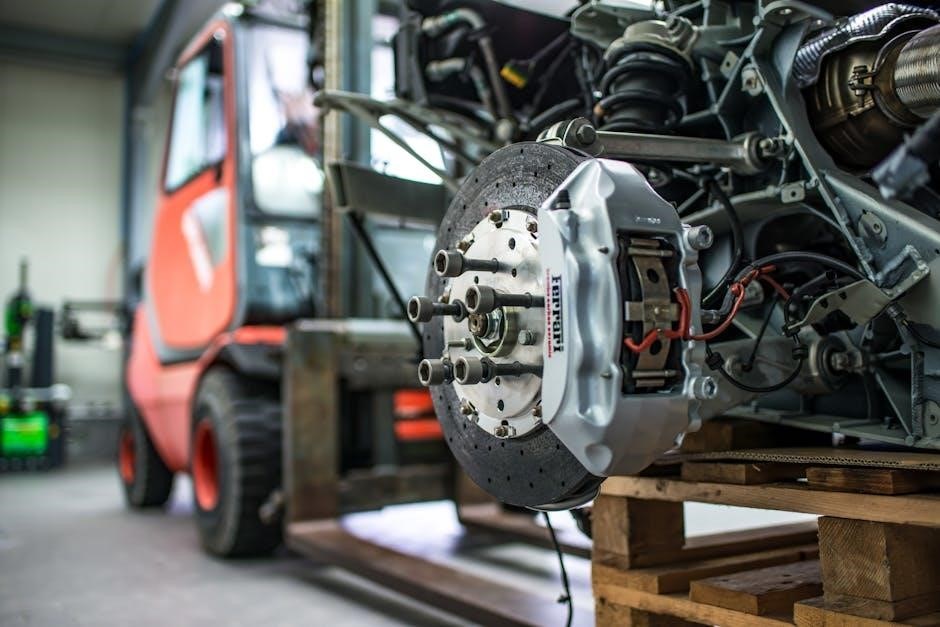air brake system pdf
An air brake system uses compressed air to operate brakes in heavy-duty vehicles and trains, ensuring safety and reliability through greater braking force and control.
1.1. Definition and Purpose
An air brake system is a pneumatic braking system that uses compressed air to activate brakes in heavy-duty vehicles and trains. Its primary purpose is to ensure safe and reliable braking by converting compressed air into mechanical energy to engage foundation brakes. This system is crucial for controlling heavy vehicles, providing greater braking force and stability compared to hydraulic systems. It is widely used in trucks, buses, and trains to enhance safety and operational efficiency on the road and railways.
1.2. Importance in Heavy-Duty Vehicles
Air brake systems are essential in heavy-duty vehicles for ensuring safety and control. They provide a reliable and consistent means of braking, especially for large vehicles carrying heavy loads. Unlike hydraulic systems, air brakes offer greater braking force and faster response times, reducing the risk of accidents. Additionally, air brakes are less prone to failure under extreme conditions, making them critical for maintaining safety in trucks, buses, and industrial machinery. This reliability ensures compliance with federal safety standards and protects both passengers and cargo.
History of Air Brake Systems
The air brake system was invented by George Westinghouse in 1872, revolutionizing railway safety. It evolved from railways to road vehicles, becoming a critical braking solution for heavy-duty applications.
2.1. Invention by George Westinghouse
George Westinghouse revolutionized braking technology by inventing the air brake system in 1869. His design allowed trains to apply brakes uniformly across all cars, significantly improving safety and reducing stopping distances. Westinghouse’s system used compressed air to transmit brake signals, ensuring synchronized braking. This innovation was first applied in railways and later adapted for road vehicles, becoming a cornerstone of modern braking systems. His invention marked a turning point in transportation safety, earning him widespread acclaim;
2.2. Evolution in Railways and Road Vehicles
The air brake system evolved significantly from its initial use in railways to its adaptation in road vehicles. In the early 20th century, it became standard for heavy-duty trucks and buses. The system was modified to handle the demands of road transport, including the addition of dual air chambers for improved control. This evolution ensured safer and more efficient braking, particularly for heavier vehicles, revolutionizing both industries’ safety standards and operational efficiency over time.

Key Components of Air Brake Systems
The air brake system consists of a compressor, air reservoir, brake chamber, and control valve. These components work together to compress, store, and regulate air pressure for braking.
3.1. Compressor
The compressor is the heart of the air brake system, responsible for generating and supplying compressed air. Typically belt-driven, it draws in ambient air through an intake filter, compresses it, and delivers it to the air reservoir. Equipped with a safety valve to prevent over-pressurization, the compressor ensures a consistent air supply for braking operations; Its reliability and efficiency are critical for the overall performance and safety of the air brake system in heavy-duty vehicles.
3.2. Air Reservoir
The air reservoir is a critical component that stores compressed air generated by the compressor. Located between the compressor and the brake chambers, it ensures a steady supply of pressurized air for braking operations. The reservoir acts as a buffer, maintaining consistent air pressure and enabling quick brake applications. Its capacity varies depending on vehicle size, ensuring reliable performance even during repeated braking. Proper maintenance of the air reservoir is essential for system efficiency and safety.
3.3. Brake Chamber
The brake chamber converts compressed air from the air reservoir into mechanical force to apply the brakes. It houses a diaphragm or piston that moves when air pressure increases, activating the brake shoes or pads. This component is vital for translating air pressure into physical braking action, ensuring the vehicle slows or stops safely. Brake chambers vary in size and type, depending on the vehicle’s braking requirements, and are essential for reliable braking performance in air brake systems.
3.4. Control Valve
The control valve regulates the airflow within the air brake system, responding to the driver’s input. It directs compressed air to the brake chambers when the brake pedal is pressed, ensuring precise control over braking. This valve is crucial for modulating braking force and maintaining system responsiveness. Its operation ensures smooth and safe braking by accurately managing air pressure distribution, making it a critical component for reliable braking performance in air brake systems.

Operation of Air Brake Systems
Air brake systems function by compressing, storing, and distributing air to apply brakes. The process involves air supply, storage, and controlled release to activate braking mechanisms safely and efficiently.
4.1. Air Supply and Storage
The air brake system begins with the compressor, which generates pressurized air. This air is stored in reservoirs to ensure a reliable supply. The system includes governors to regulate pressure and drain valves to remove moisture and contaminants. Proper air supply and storage are critical for consistent braking performance, ensuring the system operates safely and efficiently under various conditions.
4.2. Brake Application Process
The brake application process begins when the driver presses the brake pedal, activating the control valve. Compressed air flows through the valve and into the brake chambers. This air pressure pushes a diaphragm or piston, which moves the push rod to apply the brakes. The intensity of braking depends on the air pressure applied, ensuring precise control. This process is crucial for safe and effective stopping in heavy-duty vehicles, relying on the system’s ability to transmit pressure accurately.
4.3. Brake Release Mechanism
The brake release mechanism occurs when the driver releases the brake pedal, deactivating the control valve. This allows compressed air to escape from the brake chambers, reducing pressure. The diaphragm or piston returns to its resting position, releasing the push rod and disengaging the brakes. Spring force ensures components return to their original state. The process is smooth and precise, enabling proper vehicle control. Automatic adjustment of brake shoes or pads during release ensures consistent braking performance over time.

Types of Air Brake Systems
Air brake systems are categorized into S-Cam Drum Brake, Disc Brake, and Emergency Brake Systems, each designed for specific applications and performance requirements.
5.1. S-Cam Drum Brake System
The S-Cam Drum Brake System is a widely used air brake configuration in heavy-duty vehicles. It utilizes an S-shaped cam that rotates to push brake shoes against the drum, creating friction to slow or stop the vehicle. Known for its reliability and durability, this system is commonly found in trucks and buses. The S-Cam design provides consistent braking performance and is relatively simple to maintain, making it a preferred choice for demanding applications.
5.2. Disc Brake System
The Disc Brake System is a modern air brake configuration that offers superior braking efficiency. It features a rotor and caliper design, where brake pads apply pressure to the disc, generating friction. This system provides consistent performance, minimal fade, and improved heat dissipation compared to drum brakes. Disc brakes are increasingly used in heavy-duty vehicles due to their reliability and reduced maintenance needs, making them ideal for high-performance and safety-critical applications in modern transportation.
5.3. Emergency Brake System
The Emergency Brake System is a critical failsafe mechanism in air brake setups, designed to engage automatically in case of system failure or sudden loss of pressure. It ensures immediate braking by utilizing stored compressed air, providing an additional layer of safety. This system is crucial for preventing accidents, especially in heavy-duty vehicles. It operates independently of the primary braking controls, making it a vital component for emergency situations and enhancing overall vehicle safety and reliability.

Advantages of Air Brake Systems
Air brake systems provide superior braking efficiency, consistent performance, and enhanced safety. They offer faster response times, better control, and reliability, especially in heavy-duty vehicles.
6.1. Greater Braking Force
Air brake systems deliver superior stopping power by utilizing compressed air to apply force on brake components. This results in faster and more consistent braking across all wheels, enhancing control and stability. Unlike hydraulic systems, air brakes provide a uniform pressure distribution, ensuring reliable performance even in heavy-duty vehicles. The increased braking force significantly reduces stopping distances, improving safety in demanding conditions. This capability is crucial for large vehicles, where effective braking is essential for preventing accidents and maintaining operational safety.
6.2. Reliability and Durability
Air brake systems are renowned for their reliability and durability, making them ideal for heavy-duty applications. Constructed with robust components like high-quality steel and durable seals, these systems withstand harsh operating conditions. Their consistent performance ensures minimal downtime, and with proper maintenance, they maintain optimal functionality over extended periods. This durability contributes to the overall safety and efficiency of vehicles equipped with air brake systems.

Maintenance and Inspection
Regular inspections and maintenance are critical to ensure air brake systems function safely and efficiently. Daily checks for air leaks, worn components, and proper pressure levels are essential.
7.1. Regular Service Requirements
Regular maintenance is vital for air brake systems to ensure optimal performance. This includes checking the compressor, reservoir, and hoses for leaks or damage. Brake chambers, valves, and linings should be inspected for wear. Air filters and dryers must be cleaned or replaced as needed. Proper lubrication of moving parts and timely replacement of worn components are essential. Regular draining of moisture from reservoirs prevents corrosion. Adhering to manufacturer guidelines ensures safety and compliance with regulations, minimizing the risk of system failure.
7.2. Common Issues and Solutions
Common issues in air brake systems include air leaks, low air pressure, and brake imbalance. Leaks can occur in hoses, connections, or seals, requiring immediate inspection and replacement. Low pressure may result from compressor failure or excessive moisture, necessitating maintenance of the compressor and air dryer. Brake imbalance can cause uneven stopping, requiring adjustment or replacement of brake shoes or drums. Regular inspections and timely repairs ensure optimal performance and safety, preventing potential system failures during operation.

Safety Regulations and Standards
Air brake systems must comply with FMCSA guidelines, including regular testing, inspection, and maintenance to ensure safety. Adherence to FMVSS 121 standards is mandatory for optimal performance and road safety.
8.1. Federal Motor Carrier Safety Administration (FMCSA) Guidelines
The FMCSA mandates strict safety standards for air brake systems in commercial vehicles. Regular inspections, performance tests, and maintenance are required to ensure compliance. Drivers must conduct pre-trip inspections, and fleets must maintain detailed records. Non-compliance can result in penalties and operational shutdowns. These guidelines aim to reduce accidents by ensuring reliable braking performance and adherence to safety protocols for heavy-duty vehicles on U.S. roadways.
8.2. Compliance Requirements
Compliance with air brake system regulations ensures safety and legal operation. Vehicles must meet FMVSS 121 standards, including proper installation and functioning of components. Regular maintenance, such as brake shoe adjustments and fluid checks, is mandatory. Drivers and technicians must be trained on air brake systems. Non-compliance can lead to fines or vehicle immobilization. Adherence to these requirements is critical for road safety and regulatory approval, ensuring reliable braking performance in commercial vehicles.

Troubleshooting Common Problems
Troubleshooting air brake systems is crucial for maintaining safety and efficiency. Common issues include air leaks, low pressure, and brake fade. Regular inspections and proper maintenance can prevent malfunctions and ensure reliable braking performance.
9.1. Air Leaks and Pressure Loss
Air leaks and pressure loss are common issues in air brake systems, often caused by damaged hoses, worn seals, or loose connections. Regular inspections can identify hissing sounds or visible leaks. Using soapy water on fittings helps detect air escapes. Addressing these issues promptly ensures proper braking performance and safety. Replacing faulty components and tightening connections are typical solutions. Preventative maintenance is key to avoiding pressure loss and maintaining system reliability over time.
9.2. Brake Fade and Performance Issues
Brake fade occurs when repeated braking causes overheating, reducing stopping power. This is common in heavy-duty vehicles with frequent braking. Worn brake pads, misaligned shoes, or contaminated linings can exacerbate the issue. Drivers may notice a spongy pedal or delayed response. Solutions include inspecting and replacing worn components, ensuring proper brake adjustment, and allowing cooling periods between stops. Regular maintenance and proper drivetrain management are crucial to prevent performance degradation and ensure safe operation.

Market Trends and Industry Growth
The air brake system market is growing due to increasing demand in automotive and transportation sectors, integration of advanced technologies, and adherence to environmental regulations. Emerging markets drive growth.
10.1. Global Market Size and Projections
The global air brake system market is expanding steadily, driven by rising demand for heavy-duty vehicles and stringent safety regulations. In 2023, the market was valued at USD 12.8 billion, with a projected CAGR of 4.5% through 2030. Growth is fueled by advancements in braking technologies and increasing adoption in automotive and industrial sectors. Emerging markets, particularly in Asia-Pacific, are expected to contribute significantly to market expansion due to rapid industrialization and infrastructure development.
10.2. Technological Advancements
Technological advancements in air brake systems are transforming the industry, with a focus on improving safety, efficiency, and sustainability. Autonomous vehicles now integrate advanced air brake systems with ADAS (Advanced Driver-Assistance Systems) for enhanced control. Regenerative braking systems are being developed to recover energy, reducing wear and tear. Predictive maintenance using IoT sensors detects potential failures early. Eco-friendly designs, such as lower emissions and quieter operations, are gaining traction. These innovations are driving the evolution of air brake technology, ensuring safer and more reliable braking solutions for modern vehicles.

Future Developments in Air Brake Technology
Future developments include autonomous integration, energy-efficient systems, and advanced safety features to reduce environmental impact and enhance overall performance.
11.1. Integration with Autonomous Vehicles
The integration of air brake systems with autonomous vehicles is a promising development, enhancing safety and efficiency. Autonomous systems require precise control over braking, and air brake technology can provide rapid, reliable actuation. Advanced algorithms and sensors will optimize braking performance, reducing stopping distances and improving overall vehicle safety. This integration also enables better coordination between the vehicle’s AI and braking mechanisms, ensuring seamless communication for emergency stops or adaptive cruise control. Manufacturers are developing specialized control modules to meet these demands, fostering innovation in both automotive and braking technologies.
11.2. Sustainable and Energy-Efficient Systems
Modern air brake systems are evolving to prioritize sustainability and energy efficiency. Manufacturers are developing lightweight components and eco-friendly materials to reduce fuel consumption and emissions. Energy recovery systems are being integrated to capture and reuse braking energy, minimizing waste. Additionally, advancements in brake design aim to reduce wear and tear, lowering maintenance needs and extending component lifespan. These innovations align with global environmental goals, making air brake systems more sustainable for future transportation needs.
Air brake systems are essential for vehicle safety and efficiency. Their evolution has significantly enhanced performance, and future innovations promise even greater sustainability and reliability.
12.1. Summary of Key Points
Air brake systems are critical for safe and efficient vehicle operation. They rely on compressed air to apply brakes, offering reliability and superior braking force. Key components include compressors, reservoirs, and brake chambers. Regular maintenance and adherence to safety standards are essential for optimal performance. Advances in technology, such as autonomous integration and energy-efficient designs, promise a sustainable future. Understanding these systems is vital for ensuring safety and compliance in modern transportation.
12.2. Future Outlook
The future of air brake systems is poised for innovation, driven by advancements in autonomous vehicles and sustainable technologies. Integration with autonomous systems will enhance safety and efficiency. Energy-efficient designs and reduced air consumption are expected to dominate upcoming developments. Regulatory updates will ensure compliance with evolving safety standards. The industry is likely to see increased adoption of advanced materials and digital monitoring systems, further improving reliability and performance. These trends underscore a promising and progressive trajectory for air brake technology.
